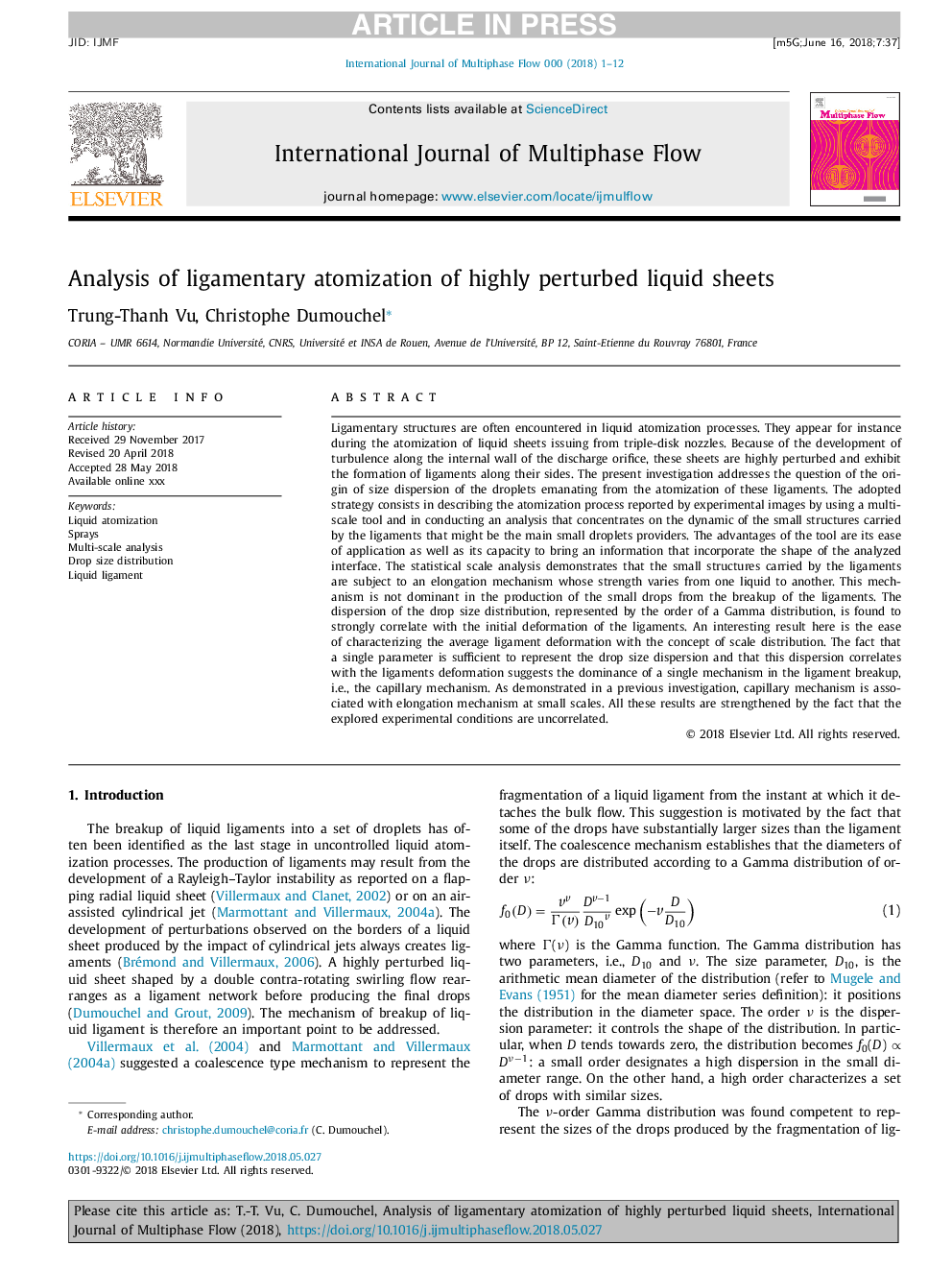| کد مقاله | کد نشریه | سال انتشار | مقاله انگلیسی | نسخه تمام متن |
|---|---|---|---|---|
| 8941988 | 1645052 | 2018 | 12 صفحه PDF | دانلود رایگان |
عنوان انگلیسی مقاله ISI
Analysis of ligamentary atomization of highly perturbed liquid sheets
ترجمه فارسی عنوان
تجزیه و تحلیل اتمیزاسیون لیگاماناسین ورق های مایع بسیار مضر
دانلود مقاله + سفارش ترجمه
دانلود مقاله ISI انگلیسی
رایگان برای ایرانیان
کلمات کلیدی
اتمیزه مایع، اسپری ها، تجزیه و تحلیل چند مقیاس توزیع اندازه قطره، رباط مایع،
ترجمه چکیده
ساختارهای سازنده اغلب در فرایندهای اتمیزه شدن مایع مواجه می شوند. به عنوان مثال در هنگام اتمیزه کردن ورق های مایع که از نازل سه دیسک تهیه می شوند، به نظر می رسد. با توجه به ایجاد آشفتگی در امتداد دیواره داخلی تخلیه تخلیه، این ورقه ها بسیار متضاد هستند و تشکیل رباط ها در امتداد دو طرف آنها را نشان می دهد. تحقیق حاضر مساله مربوط به منشا پراکندگی اندازه قطرات ناشی از اتمیزه کردن این لیگامان ها را بررسی می کند. استراتژی اتخاذ شده شامل توصیف فرایند اتمیزهی گزارش شده توسط تصاویر آزمایشی با استفاده از یک ابزار چند بعدی و انجام تحلیل است که تمرکز بر پویایی ساختارهای کوچک انجام شده توسط لیگامانها که ممکن است ارائه دهنده اصلی قطرات کوچک باشد. مزایای این ابزار، سهولت کاربرد آن و ظرفیت آن برای ارائه اطلاعاتی است که شکل رابط تجزیه و تحلیل شده را شامل می شود. تجزیه و تحلیل مقیاس آماری نشان می دهد که سازه های کوچک انجام شده توسط رباط ها به یک مکانیزم کشش بستگی دارد که قدرت آن از یک مایع به دیگری متفاوت است. این مکانیزم در تولید قطره های کوچک از شکستن لیگامان غالب نیست. پراکندگی توزیع اندازه قطره، که به ترتیب توزیع گاما نشان داده می شود، به شدت با تغییر شکل اولیه لیگامان ارتباط دارد. یک نتیجه جالب در اینجا، سهولت توصیف تغییر شکل کلی لثه ها با مفهوم توزیع مقیاس است. واقعیت این است که یک پارامتر واحد برای نشان دادن پراکندگی اندازه قطره کافی است و این پراکندگی با تغییر شکل لبه ها همبستگی دارد و حاکی از تسلط یک مکانیزم تک در شکست لجن، یعنی مکانیسم مویرگی است. همانطور که در تحقیقات قبلی نشان داده شده است، مکانیزم مویرگی با مکانیزم کشش در مقیاس کوچک همراه است. تمام این نتایج توسط این واقعیت تقویت شده است که شرایط آزمایش شده مورد بررسی همخوانی ندارند.
موضوعات مرتبط
مهندسی و علوم پایه
مهندسی شیمی
جریان سیال و فرایندهای انتقال
چکیده انگلیسی
Ligamentary structures are often encountered in liquid atomization processes. They appear for instance during the atomization of liquid sheets issuing from triple-disk nozzles. Because of the development of turbulence along the internal wall of the discharge orifice, these sheets are highly perturbed and exhibit the formation of ligaments along their sides. The present investigation addresses the question of the origin of size dispersion of the droplets emanating from the atomization of these ligaments. The adopted strategy consists in describing the atomization process reported by experimental images by using a multi-scale tool and in conducting an analysis that concentrates on the dynamic of the small structures carried by the ligaments that might be the main small droplets providers. The advantages of the tool are its ease of application as well as its capacity to bring an information that incorporate the shape of the analyzed interface. The statistical scale analysis demonstrates that the small structures carried by the ligaments are subject to an elongation mechanism whose strength varies from one liquid to another. This mechanism is not dominant in the production of the small drops from the breakup of the ligaments. The dispersion of the drop size distribution, represented by the order of a Gamma distribution, is found to strongly correlate with the initial deformation of the ligaments. An interesting result here is the ease of characterizing the average ligament deformation with the concept of scale distribution. The fact that a single parameter is sufficient to represent the drop size dispersion and that this dispersion correlates with the ligaments deformation suggests the dominance of a single mechanism in the ligament breakup, i.e., the capillary mechanism. As demonstrated in a previous investigation, capillary mechanism is associated with elongation mechanism at small scales. All these results are strengthened by the fact that the explored experimental conditions are uncorrelated.
ناشر
Database: Elsevier - ScienceDirect (ساینس دایرکت)
Journal: International Journal of Multiphase Flow - Volume 107, October 2018, Pages 156-167
Journal: International Journal of Multiphase Flow - Volume 107, October 2018, Pages 156-167
نویسندگان
Trung-Thanh Vu, Christophe Dumouchel,
